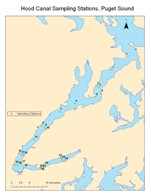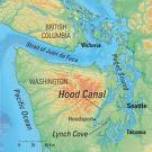| Home |
| About Us |
| Methods |
| Sample Sites
|
| Data Repository |
| Acknowledgements |
Hood Canal |
Introduction: Hood Canal is located in western Washington State and is part of the Puget Sound water body. A sill near Admiralty Inlet separates the canal from Puget Sound. The depths of the canal vary between a depth of 175m and 40m or less. A 180 degree bend called the Great Bend and other geographical features affect the water flow in and out of Hood Canal. The canal receives marine water from the Pacific Ocean via Admiralty Inlet, and receives freshwater on its western shoreline from rivers and streams. Human activity in and near the canal consist of small communities and businesses, cabins and resorts. There are no large industrial centers or big cities along the waterway. Due to stratification and modest freshwater input, bottom water in southern Hood Canal has a long residence time, on the order of one to four months, and little exchange with overlying oxygenated water (Warner et al., 2001; Babson et al., 2006). As a result, the dissolved oxygen (DO) concentrations in parts of the canal can become very low, a condition commonly referred to as hypoxia (further information from the actual study can be found at this WA State Dept of Ecology web site http://www.ecy.wa.gov/pubs/0703040.pdf ) The objective of the class was to collect discrete and continuous water property parameters, microscopic biological diversity and quantity, and sediment analysis for Hood Canal. More studies would need to be conducted in Hood Canal to determine the exact cause of the lowering oxygen levels and its effect on marine life. Mobile creatures have the ability to escape the area when oxygen levels get too low, but some smaller organisms and sediment dwellers suffer through these stress events. Seasonal factors, nutrient loading, phytoplankton productivity and human activity are both cause and effects of changes in oxygen levels.
|
|
Hood Canal sampling stations (click to enlarge.) Hood Canal overview. Example of stratification and mixing of salt and freshwater.
|


